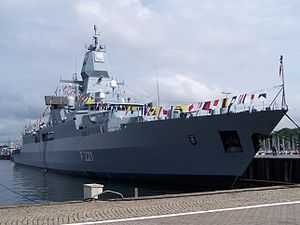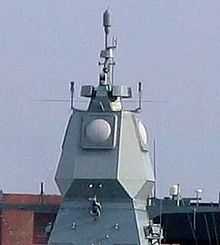Sachsen-class frigate
 Hamburg in the Mediterranean in March 2013 | |
| Class overview | |
|---|---|
| Builders: |
Blohm + Voss Howaldtswerke-Deutsche Werft Nordseewerke |
| Operators: |
|
| Preceded by: | Lütjens-class destroyer |
| Planned: | 4 |
| Completed: | 3 |
| Active: |
Sachsen Hamburg Hessen |
| General characteristics | |
| Displacement: | 5,800 tonnes |
| Length: | 143 m (469 ft) |
| Beam: | 17.44 m (57.2 ft) |
| Draft: | 6 m (20 ft) |
| Propulsion: | CODAG (combined diesel and gas) 2 propeller shafts, controllable-pitch propellers 2 MTU V20 diesel engines, 7.4 MW each 1 General Electric LM2500 gas turbine 2 Renk ASM 195 F gearboxes (for the diesel engines) 1 Renk AS 2/290 gearbox (gas turbine and cross connection) 4 1000 kW Deutz 16/628 diesel-generators |
| Speed: | 29 knots (54 km/h; 33 mph) |
| Range: | 4,000 nmi (7,400 km; 4,600 mi)+ at 18 kn (33 km/h; 21 mph) |
| Complement: | 230 crew + 13 aircrew |
| Sensors and processing systems: | 1 Thales Nederland SMART-L long-range air and surface surveillance radar (D band) 1 Thales Nederland APAR air and surface search, tracking and guidance radar (I band) 1 Thales Nederland Sirius IRST long-range infrared surveillance and tracking system (fitted for but not with) 2 STN Atlas 9600-M multi-function I/J band ARPA radars 1 STN Atlas MSP 500 electro-optical fire control system 1 STN Atlas DSQS-24B bow sonar |
| Electronic warfare and decoys: | 1 FL 1800 S II ECM suite 6 Sippican Hycor SRBOC launcher |
| Armament: |
|
| Aircraft carried: | 2 Sea Lynx Mk.88A or 2 NH90 helicopters equipped with torpedoes, air-to-surface missiles Sea Skua, and/or heavy machine gun. |
The F124 Sachsen class is Germany's latest class of highly advanced air-defense frigates. The design of the Sachsen class frigate is based on that of the F123 Brandenburg class but with enhanced stealth features designed to deceive an opponent's radar and acoustic sensors. The class incorporates an advanced multifunction radar APAR and a SMART-L long-range radar which is purported to be capable of detecting stealth aircraft and stealth missiles.
Although designated as frigates, they are comparable to destroyers in capability and size and were intended to replace the Navy's Lütjens class. They are similar to the Dutch De Zeven Provinciën class, in that both are based on the use of a common primary anti-air warfare system built around the APAR and SMART-L radars as well as the area-defence SM-2 Block IIIA and point-defence Evolved Sea Sparrow Missile (ESSM) surface-to-air missiles.
The German government contracted for three ships in June 1996 with an option on a fourth that was provisionally to have been named Thüringen, but the option for this fourth ship was not taken up. At €2.1 billion for the three ships, the class was one of the most expensive ship building programs of the German Navy.
Design
General characteristics and machinery

The ships of the Sachsen class are 132.15 meters (433.6 ft) long at the waterline and 143 m (469 ft) long overall. They have a beam of 17.44 m (57.2 ft) and a draft of 5 m (16 ft), though the draft increases to 7 m (23 ft) at the sonar array in the bulbous bow. They displace 5,690 long tons (5,780 t) at full load. Steering is controlled by a single roll-stabilized rudder; the ships have a turning radius of 570 m (1,870 ft). The frigates have a crew of 38 officers, 64 petty officers, and 140 enlisted sailors. They have accommodations for an additional thirteen officers and sailors as part of a squadron commander's staff, and they have crew provisions for female sailors. The ships can remain at sea for 21 days at a time.[1]
The ships' hulls were designed on the pattern of the previous Brandenburg class to allow for great commonality of parts to reduce maintenance costs; they were built using MEKO modular construction and incorporate seven watertight compartments. The primary improvement over the earlier vessels is significantly the reduced radar signature. The ships were designed with a capacity for an extra 270 long tons (270 t) of weight, to allow for future additions of new weapons and sensors without compromising the ships' efficiency.[1]
The ships of the Sachsen class are equipped with a combined diesel and gas (CODAG) propulsion system. The two operating shafts work independently. The diesel engines are installed in a non-walkable sound-proof capsule. The shafts drive two five-bladed variable-pitch propellers. The General Electric LM2500 PF/MLG gas turbine is rated at 31,500 shaft horsepower (23,500 kW) and the MTU 20V 1163 TB93 diesels provide a combined 20,100 brake horsepower (15,000 kW). The total 51,600 hp (38,500 kW) propulsion system provides a top speed of 29 knots (54 km/h; 33 mph); while operating the diesels only, the ships can cruise for 4,000 nautical miles (7,400 km; 4,600 mi) at a speed of 18 kn (33 km/h; 21 mph). The ships are equipped with four 1,000 Kilowatt diesel generators that operate at 400 Volts (V) and 115 V.[1]
Armament
.jpg)
These ships were optimized for the anti-air warfare role. The primary anti-air weapons are the 32-cell Mk 41 Mod 10 vertical launching system, equipped with twenty-four SM-2 Block IIIA missiles and thirty-two Evolved Sea Sparrow missiles. Point-defense against cruise missiles is provided by a pair of 21-round Rolling Airframe Missile launchers. The ships are also equipped with two four-cell RGM-84 Harpoon anti-ship missile launchers.[1]
For defense against submarines, the frigates carry two triple-launchers for the 324 mm (12.8 in) MU90 Impact torpedoes. The ships also carry a variety of guns, including one dual-purpose 62-caliber 76-millimeter (3.0 in) gun manufactured by OTO Melara. They are also armed with two Rheinmetall 27 mm (1.1 in) MLG 27 remote-controlled autocannons in single mounts.[1]
In January 2003, Hamburg had a modified Panzerhaubitze 2000 turret with a 155 mm (6.1 in) gun fitted experimentally for the Modular Naval Artillery Concept. The experiment was a feasibility study for the projected F125-class frigate. The gun had a range of 40 nmi (74 km; 46 mi) and a rate of fire of 10 rounds per minute.[1]
Sachsen and her sister ships are equipped with a flight deck and hangar that can accommodate two Super Lynx or NH90 helicopters. The flight deck is rated to accommodate a 15 t (15 long tons; 17 short tons) helicopter in conditions up to sea state 6. The helicopter handling system from MBB-Förder und Hebesysteme uses laser guided and computer controlled manipulator arms to secure the helicopter after landing.[1]
Sensors and countermeasures

For this role the ships are equipped with an advanced sensor and weapons suite. The primary sensors for this role are the long range surveillance radar SMART-L and the multi-function radar APAR. The SMART-L and APAR are highly complementary, in the sense that SMART-L is a L band radar providing very long range surveillance while APAR is an X band radar providing precise target tracking, a highly capable horizon search capability, and missile guidance using the Interrupted Continuous Wave Illumination (ICWI) technique, thus allowing guidance of 32 semi-active radar homing missiles in flight simultaneously, including 16 in the terminal guidance phase.[2][3] The ships are also equipped with two STN Atlas 9600-M ARPA navigation radars.[4]
The STN Atlas MSP 500 electro-optical fire control system provides target acquisition and tracking for the main gun. The bow sonar is the STN Atlas Elektronik DSQS-24B.
The ship's electronic countermeasures suite includes an EADS Systems and Defence Electronics FL1800 SII ECM system and six Sippican Hycor SuperRBOC launchers which fire chaff and flares. Electronic support measures are provided by EADS Systems and Defence Electronics Maigret CESM (Communications ESM).
Ships
| Pennant number | Name | Call sign | Shipyard | Laid down | Launched | Delivered | Commissioned | Fate |
|---|---|---|---|---|---|---|---|---|
| F219 | Sachsen | DRAA | Blohm + Voss | 1 February 1999 | 20 January 2001 | 29 November 2002 | 31 December 2003 | In service |
| F220 | Hamburg | DRAB | HDW | 1 September 2000 | 16 August 2002 | September 2004 | 13 December 2004 | In service |
| F221 | Hessen | DRAC | Nordseewerke | 14 September 2001 | 26 July 2003 | 7 December 2005 | 21 April 2006 | In service |
| (F222) | Thüringen | option not taken up | ||||||
Service history
%2C_left%2C_and_the_aircraft_carrier_USS_Dwight_D._Eisenhower_(CVN_69)%2C_right%2C_take_on_fuel_and_stores_from_the_Military_Sealift_Command_fast_combat_support_ship_USNS_Bridge_130323-N-GC639-175.jpg)
All three vessels form part of the 2. Fregattengeschwader (2nd Frigate Squadron) based in Wilhelmshaven. In August 2004, Sachsen completed a series of live missile firings at the Point Mugu missile launch range off the coast of California that included a total of 11 ESSM and 10 SM-2 Block IIIA missiles. The tests included firings against target drones such as the BQM-74E Chukar III and BQM-34S Firebee I, as well as against missile targets such as the AQM-37C Jayhawk and air-launched Kormoran 1 anti-ship missiles.[2]
At the end of March 2013, Hamburg became the first German ship to fully integrate into an American carrier strike group. She was not, however, the first German warship to serve with American vessels, as Hessen took part in inter-operability exercises with the carrier USS Harry S. Truman in 2010, before departing in the Mediterranean Sea. In addition, German warships participating in Operation Atalanta against pirates around the Horn of Africa frequently operate in conjunction with American ships.[5]
Exports
Rumors emerged in July 2013 that Israel has agreed to procure two destroyers from Germany for €1 billion. These have been rumored to be Sachsen-class vessels.[6][7]
Footnotes
- ↑ 1.0 1.1 1.2 1.3 1.4 1.5 1.6 Wertheim, p. 245
- ↑ 2.0 2.1 Lok, Joris Janssen (October 2005). "Live firing tests rewrite the guiding principles". Jane's Navy International 110: 38–40.
- ↑ Friedman, p. 263
- ↑ Wertheim, p. 237
- ↑ Gorman, Timothy (4 April 2013). "Hamburg First German Ship to Deploy in U.S. Carrier Strike Group". US Navy. Retrieved 21 April 2013.
- ↑ "Report: Germany to sell Israel 2 destroyers for 1 billion euros". The Jerusalem Post. 7 December 2013. Retrieved 24 January 2014.
- ↑ "With Natural Gas Fields in the Eastern Mediterranean, Israel Now Has a New Front: the Sea". Tablet Magazine. 17 January 2014. Retrieved 24 January 2014.
References
- Friedman, Norman (2006). The Naval Institute Guide to World Naval Weapon Systems. Annapolis, MD: Naval Institute Press. ISBN 9781557502629.
- Wertheim, Eric (2007). The Naval Institute Guide to Combat Fleets of the World: Their Ships, Aircraft, and Systems. Annapolis, MD: Naval Institute Press. ISBN 9781591149552.
External links
| Wikimedia Commons has media related to Sachsen class. |
- Fregatte SACHSEN-Klasse (in German) - @ Marine (official homepage of the German Navy)
- Fregatte "Sachsen" (F124) (in German) @ hansa-online.de
| ||||||||||||||
| ||||||||||||||||||||||||||||||